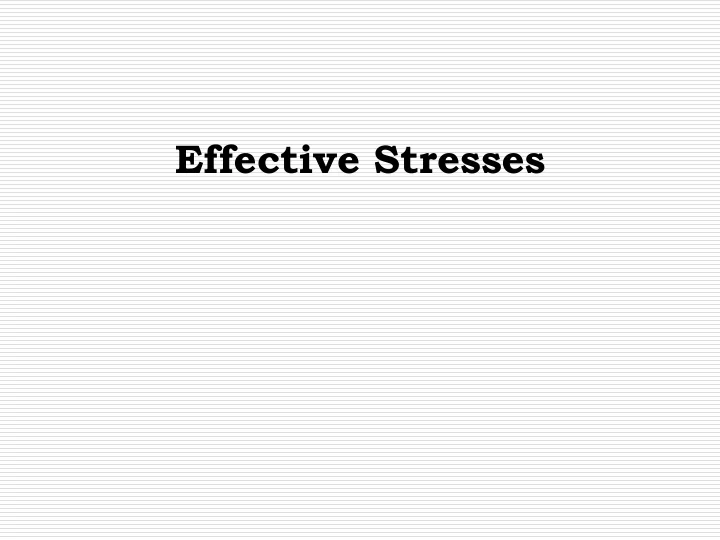

Effective Stresses
Outlines Introduction The principle of effective stress Response of effective stress to a change in total stress Partially saturated soils Influence of seepage on effective stress
Introduction A soil can be visualized as a skeleton of solid particles enclosing continuous voids which contain water and/or air. For the range of stresses usually encountered in practice the individual solid particles and water can be considered incompressible; air, on the other hand, is highly compressible. The volume of the soil skeleton as a whole can change due to rearrangement of the soil particles into new positions, mainly by rolling and sliding, with a corresponding change in the forces acting between particles. The actual compressibility of the soil skeleton will depend on the structural arrangement of the solid particles. In a fully saturated soil, since water is considered to be incompressible, a reduction in volume is possible only if some of the water can escape from the voids. In a dry or a partially saturated soil a reduction in volume is always possible due to compression of the air in the voids, provided there is scope for particle rearrangement.
THE PRINCIPLE OF EFFECTIVE STRESS Effective stress: the forces transmitted through the soil skeleton from particle to particle was recognized in 1923 By Terzaghi The the principle applies only to fully saturated soils and relates the following three stresses: The total normal stress ( ) on a plane within the soil mass, being 1. the force per unit area transmitted in a normal direction across the plane 2. The pore water pressure (u), being the pressure of the water filling the void space between the solid particles; The effective normal stress ( ) on the plane, representing the 3. stress transmitted through the soil skeleton only.
Effective vertical stress due to self-weight of soil (overburden pressure) The total vertical stress (i.e. the total normal stress on a horizontal plane) at depth z is equal to the weight of all material (solids + water) per unit area above that depth, i.e. The pore water pressure (static or hydrostatic) at any depth will be hydrostatic since the void space between the solid particles is continuous, so at depth z The effective vertical stress at depth z will be where is the buoyant unit weight of the soil.
Component of Pore water pressure If the soil subjected to seepage or to the load the pore water pressure (pwp). At any time during drainage the overall pore water pressure (u) is equal to the sum of the static and excess components, i.e. The reduction of excess pore water pressure as drainage takes place is described as dissipation and when this has been completed (i.e. when ue= 0) the soil is said to be in the drained condition. Prior to dissipation, with the excess pore water pressure at its initial value, the soil is said to be in the undrained condition. It should be noted that the term ‘drained’ does not mean that all water has flowed out of the soil pores: it means that there is no stress-induced pressure in the pore water. The soil remains fully saturated throughout the process of dissipation.
Example A layer of saturated clay 4m thick is overlain by sand 5m deep, the water table being 3m below the surface. The saturated unit weights of the clay and sand are 19 and 20 kN/m 3 , respectively; above the water table the unit weight of the sand is 17 kN/m 3 . Plot the values of total vertical stress and effective vertical stress against depth. If sand to a height of 1m above the water table is saturated with capillary water, how are the above stresses affected?
Example What Would happen to If sand to a height of 1m above the water table is saturated with capillary water, how are the above stresses affected? Effect of capillary rise The water table is the level at which pore water pressure is atmospheric (i.e. u = 0). Above the water table, water is held under negative pressure and, even if the soil is saturated above the water table, does not contribute to hydrostatic pressure below the water table. The only effect of the 1m capillary rise, therefore, is to increase the total unit weight of the sand between 2 and 3mdepth from17 to 20 kN/m 3 , an increase of 3 kN/m 3 . Both total and effective vertical stresses below 3m depth are therefore increased by the constant amount 3 x 1 = 3.0 kN/m 2 , pore water pressures being unchanged.
Example A 5m depth of sand overlies a 6m layer of clay, the water table being at the surface; the permeability of the clay is very low. The saturated unit weight of the sand is 19 kN/m3 and that of the clay is 20 kN/m3. A 4m depth of fill material of unit weight 20 kN/m3 is placed on the surface over an extensive area. Determine the effective vertical stress at the centre of the clay layer (a) immediately after the fill has been placed, assuming this to take place rapidly and (b) many years after the fill has been placed. a. b.
Imperial (B.S.) Unit example Total Stress Q Hydrostatic Stress Stress (psf) Effective Stress 0 Loose Fine Sand G.W.T 10 3 = 105 lb / ft f ' 30 o = 20 Medium Dense Sand Depth (ft) 30 3 = 120 lb / ft f ' 35 o = 50 Dense Sand 3 = 125 lb / ft f ' 37.5 o = 70
Example +M +N For the sheet pile shown find the ’in point M and N shown in the figure use for soil 20kN/m 3
Recommend
More recommend